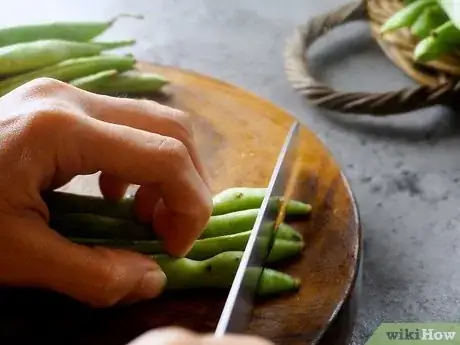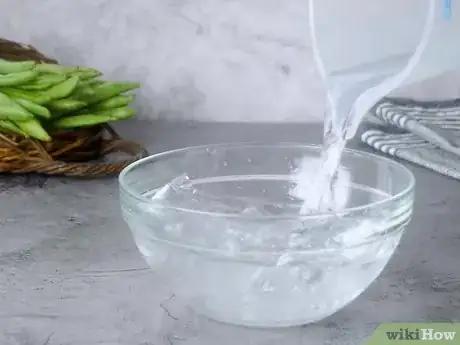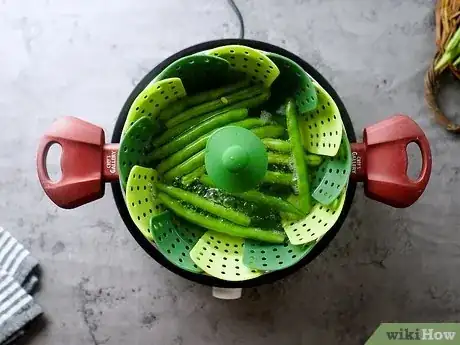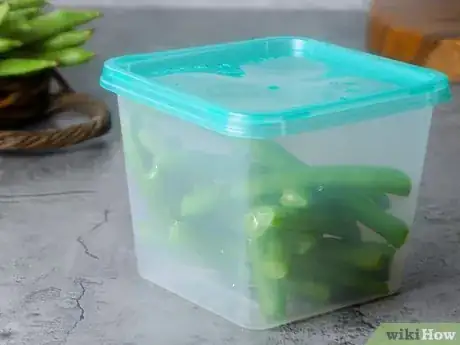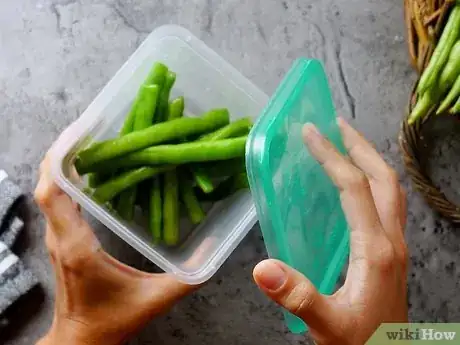This article was co-authored by Ollie George Cigliano. Ollie George Cigliano is a Private Chef, Food Educator, and Owner of Ollie George Cooks, based in Long Beach, California. With over 20 years of experience, she specializes in utilizing fresh, fun ingredients and mixing traditional and innovative cooking techniques. Ollie George holds a BA in Comparative Literature from The University of California, Berkeley, and a Nutrition and Healthy Living Certificate from eCornell University.
This article has been viewed 185,929 times.
Blanching fresh beans is an essential step prior to freezing, but it is also the method professional chefs use to prepare the beans for sauteing, stir frying, or using in salads. Blanching involves boiling the beans for a short time, then rapidly cooling them by placing them in chilled water. When done correctly, this process destroys the enzymes and bacteria in the green beans that will alter the flavor and color when frozen or if there is a delay before serving them. Read on to find out how to perform this process correctly.
Steps
Blanching the Beans
-
1Use this method for any raw, fresh beans. The method is almost identical regardless of what beans you are blanching. While one reason to blanch is to preserve the bright color of green beans or lima beans, any fresh bean benefits from blanching to preserve its flavor and nutrients.[1]
- Dried beans require different cooking methods, since blanching will not fully cook them.
-
2Wash the beans under fresh running water to remove any debris and dirt. To wash beans, you can place them in a colander or right in the clean prep sink. The blanching should remove dirt as well, so you do not need to clean the beans thoroughly.[2]
- Alternatively, you can fill the prep sink with cool water, bathe the beans, and drain.
Advertisement -
3If preparing green beans or other long beans, cut off the thick stem end with a small knife. It is not necessary to remove both ends of the bean.
- If the beans are particularly long you may choose to cut them in half. This will not affect the blanching process, but may make them easier to include in a salad or other dish.
-
4Boil a pot of water. Heat a pot of water to boiling, using approximately one gallon for each pound of beans (8 liters of water per kilogram of beans). If you are only blanching a handful or two of beans, you do not need to measure precisely.
- Optionally, add salt to the water for flavor.
- Leave enough space in the pot to fit the beans. If the amount of water required does not fit within approximately 2/3 of the pot, use a larger pot or blanch the beans in multiple batches.
-
5Prepare a bowl of chilled water. Prepare the cold water bath while the water is boiling, since the beans will only take a few minutes to boil. The water will work best if it is 60ºF (15.5ºC) or below, in order to rapidly cool the beans before they begin to lose nutrients and flavor.
- Ice is recommended to keep this water cold. If you are blanching a large quantity of beans, use approximately equal amounts of ice and beans by weight.[3]
- If the cold tap water from your sink stings or numbs your hand, it is cold enough to use. This water will warm to room temperature quickly, however, so if you are not using ice you may wish to fill the water bowl toward the end of the boiling process. Replace the water frequently to keep it cold if you are blanching more than one pot of beans.
-
6Boil the beans for about three minutes, using a timer. Add the beans to the water and start timing them once the water has returned to a boil. Boil green beans and other long beans for 3 minutes. Other types of bean, including lima, butter, and pinto beans, will require 2 to 4 minutes depending on size.[4] The beans will look bright green and taste cooked but still crisp when they are done blanching.[5]
- If the water takes more than 60 seconds to return to a boil, you may be using too much water. Reduce the amount of water next time to avoid losing flavor and nutrients.
- If you have a blanching or steaming basket, you may place the beans inside it and lower it into the water. This makes it possible to remove the beans without draining your water, which can then be used to blanch the next batch of beans or cook other foods.
-
7Chill the beans. Once the beans are ready, remove the beans from the boiling water and submerge them in the cold water bath until they are cold to the touch. Removing the beans from the hot water can be accomplished by draining the beans through a strainer, or by lifting out the blanching basket if you used one. You can also use tongs, a spider, or a slotted spoon.
- This sudden chilling process is sometimes called "shocking".
- Leave the beans in for approximately 3 minutes if you are not sure whether they are cool.
-
8Drain the cooled beans. Once the beans are cold, drain away the ice water or remove them from the bath with a slotted spoon. Your beans are now blanched and ready to use in a salad, casserole, or stir fry. Because the blanching process has sealed in nutrients and color, the blanched beans will also preserve at a higher quality if frozen.
Freezing the Beans after Blanching
-
1Dry the beans after chilling. Once the beans are blanched and chilled, they are ready for freezing. First, pat them dry to avoid ice crystals damaging the beans.[6] You may use paper towels or a clean cloth.
-
2Place the beans in freezer-safe containers. You may use freezer bags with a resealable opening, or a vacuum sealer if you have one. If you are using a hard container, leave about 1/2 inch (1.25cm) of space at the top of the container to prevent it from cracking if the beans expand or form ice crystals.
- To remove most of the air from a resealable bag, place a drinking straw into the mostly sealed opening and suck out the air. Remove the straw and seal the rest of the way.
-
3Use within 10 months for highest quality. If blanched correctly, the frozen beans should retain their flavor, color, and nutrients for 10–12 months.[7] Using them within a few weeks will give you the best chance at high quality beans, however.
-
4Thaw before using. Remove the desired quantity of beans from the freezer and let thaw before using, or add directly to stir fries. Try to avoid refreezing food once its been thawed, as this may cause the beans to deteriorate in quality. Freezing the beans in small, separate containers may help prevent this.
Community Q&A
-
QuestionMine had this wax casing on them that was kind of slimy. How come?
 Community AnswerWell, wax beans are a type of bean that are meant to have wax on them. If these are green beans that are waxy and slimy, they may not be good anymore.
Community AnswerWell, wax beans are a type of bean that are meant to have wax on them. If these are green beans that are waxy and slimy, they may not be good anymore. -
QuestionDo beans need to be blanched prior to slicing "French style"?
 Community AnswerThey do not have to be blanched first, but the integrity of the bean holds up better when you blanch before slicing, rather than the other way around.
Community AnswerThey do not have to be blanched first, but the integrity of the bean holds up better when you blanch before slicing, rather than the other way around.
Things You'll Need
- Any type of fresh, raw beans
- Fresh water
- Knife (for green beans and other long beans)
- Salt (optional)
- Large pot
- Stovetop or other heat source
- Three minute timer
- Strainer
- Large bowl
- Ice or chilled water
Warnings
- Boiling the beans for too short or too long a time can cause the beans to break down faster than they would with no blanching at all.[10] Use a timer instead of trying to guess how long the beans have been in.⧼thumbs_response⧽
References
- ↑ http://www.eatbydate.com/what-is-blanching/
- ↑ http://nchfp.uga.edu/how/freeze/blanching.html
- ↑ http://nchfp.uga.edu/how/freeze/blanching.html
- ↑ http://nchfp.uga.edu/how/freeze/blanching.html
- ↑ http://www.allrecipes.com/article/blanching-and-shocking-vegetables/
- ↑ http://nchfp.uga.edu/how/freeze/blanching.html
- ↑ http://www.stilltasty.com/fooditems/index/16471
- ↑ http://nchfp.uga.edu/how/freeze/blanching.html
- ↑ http://nchfp.uga.edu/how/freeze/blanching.html
About This Article
Blanching fresh beans before you freeze or cook them will help preserve their color and flavor. To blanch the beans, rinse them with cool, running water. If the beans are in pods, trim off the stems. Next, bring a pot of water to a boil. Aim to use about 1 gallon (3.8 L) of water for every 1 pound (.45 kg) of beans. While the water is heating up, fill a bowl with icy cold water and set it aside. Once the water in the pot starts boiling, carefully pour in the beans or lower them in using a blanching or steaming basket. Let them boil for 3 minutes, then remove them from the pot and immediately transfer them into the cold water. Leave the beans in the ice water bath until they are cold to the touch. Drain the water, and your blanched beans are ready to cook or freeze for later. For more tips, like how to freeze your beans after they’re blanched, keep reading!


